Uniquely Positioned for Growth through Technology Advancement
Curtiss-Wright is renowned for its innovation and advanced technologies. Always adaptive, we focus the expertise of our Flow Control, Motion Control and Metal Treatment businesses on the unique demands the 21st century presents to our customers.
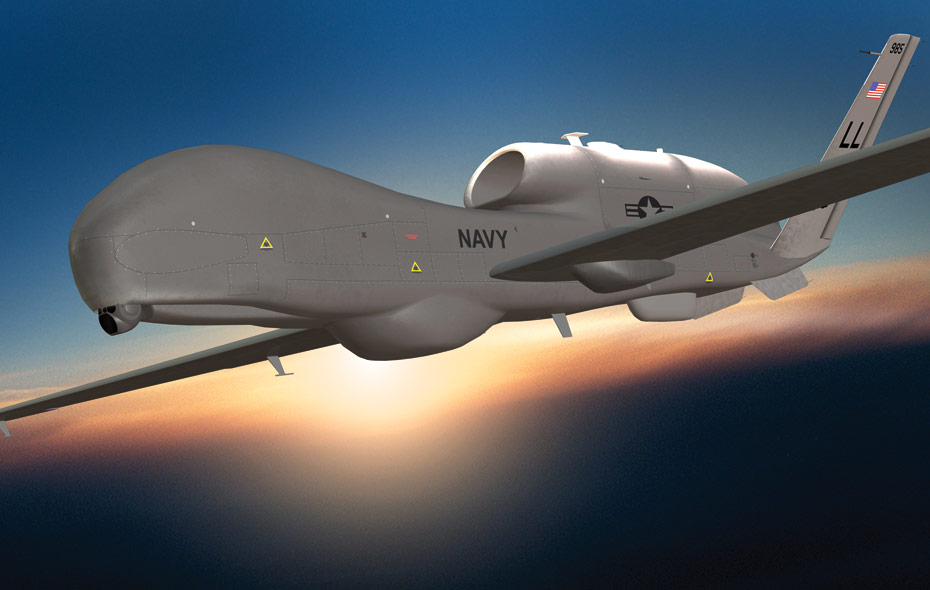
The Broad Area Maritime Surveillance Unmanned Aircraft System (BAMS UAS) will provide the U.S. Navy with a persistent maritime Intelligence, Surveillance and Reconnaissance system to protect the fleet and the capability to detect, track, classify and identify maritime and littoral targets. Curtiss-Wright supports this significant defense platform by supplying the Advanced Mission Management System for the aircraft.
We take a comprehensive approach to technology development, ever mindful that new technology widens our opportunities and expands our potential for growth. Our close, long-standing relationships with customers across industries and geographies provide insight into their current and future needs. Moreover, we also seek to leverage our success by broadening our footprint within key growth markets and continually look to apply our technology to adjacent markets.
The richness of Curtiss-Wright's technology portfolio can be seen through the benefits it brings to key parts of our customers' most vital programs.
Our defense products are critical components in a wide variety of air, sea and ground platforms in new development programs, those currently in production and for upgrades and replacement orders.
Curtiss-Wright supplies a wide variety of advanced products on numerous platforms that support the ISR functions of collection, communication, processing and presentation of information of interest that supports military users. Examples of our involvement in ISR systems include unmanned aerial vehicles (Global Hawk), dedicated ISR manned airborne platforms (P-8A Poseidon Multi-mission Maritime Aircraft) and tactical fighter aircraft (F-35 Joint Strike Fighter).
On manned aircraft, Curtiss-Wright provides critical flight-control actuation systems and stealth-capable weapons bay door systems. Our video displays, recorders and video/radar converters enable observers and pilots to select, view and record the images they need simply and with maximum fidelity. Military, police, search and rescue, border protection, coast guard and customs personnel use our video systems on helicopters in a variety of countries.
Recovery of information recorded by our Crash Survivable Memory Unit assists air accident investigators in determining the events leading up to an incident. To protect the solid-state memory that performs this critical function, Curtiss-Wright designs each recorder to withstand the harshest operating conditions, whether that means withstanding a 5,000-pound crushing force, enduring one hour engulfed by a 2,000°F flame or being submerged in 20,000 feet of water.
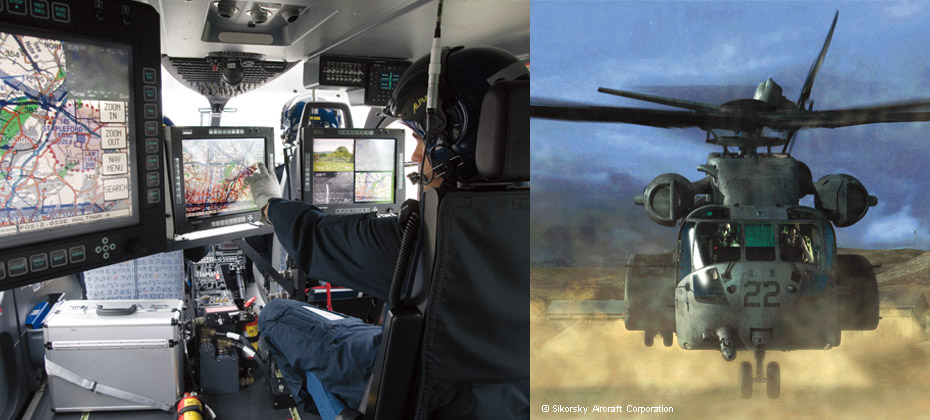
(Above Left) Our Skyquest video management system (VMS) maximizes the effectiveness of airborne ISR missions by enabling multiple operators to view, control and record live video and mapping information in helicopters. Our VMS has been chosen by leading security forces and militaries the world over, including the U.S. Army for its new Lakota light utility helicopter fleet.
(Above Right) The U.S. Marine Corps will deploy the Sikorsky CH-53K from amphibious platforms to transport personnel and equipment and carry heavy external cargo loads. Curtiss-Wright transducers will be used in the fly-by-wire systems that control the helicopter's main and tail rotors. Our data concentrator units will receive and provide various discrete, digital and analog inputs for monitoring, processing data and controlling various subsystem components. Our blade fold technology will process the required information to execute the folding or spreading of the main rotor blades, key to the CH-53K's compatibility for effective shipboard deployment.
For more than 50 years, Curtiss-Wright has supplied critical components and systems to the U.S. Navy's nuclear-powered ships. Our pumps, valves, generators, motors and control systems are aboard nuclear-powered submarines and aircraft carriers throughout the Navy's fleet. We have earned a reputation that will enable us to play a critical role as the Navy begins work on a planned class of 12 next-generation Ohio-class ballistic missile submarines to replace 14 mature submarines.
A recognized leader in the design, development, manufacture and integration of motion and fire controls, Curtiss-Wright technology is widely represented in the most advanced military ground vehicle electronics platforms, from individual components to integrated subsystems. Our technologies play a prominent role in such key platforms as the M1A2 Abrams main battle tank, the Bradley Fighting Vehicle, the Stryker Mobile Gun System, the Hoefyster modular fighting vehicle and the Pizarro fighting vehicle.
We are actively advancing electronic systems and motion control technologies for tomorrow's sophisticated defense platforms. From intelligent power controllers and vehicle power distribution to network-centric, open-system electronics architectures that reduce size, weight and power consumption, Curtiss-Wright is poised to offer solutions for the evolving needs in the next generation of modern ground combat vehicles.
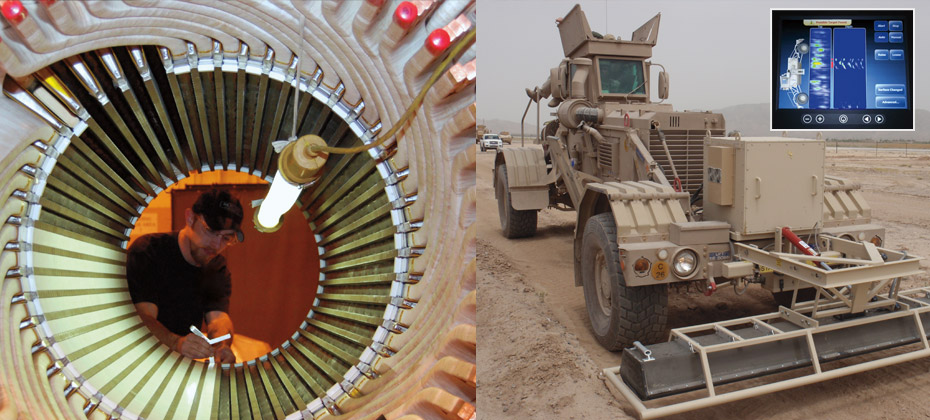
(Above Left) This wound stator core is an integral component for one of the largest motors manufactured by Curtiss-Wright. It will be part of the AP1000™reactor coolant pump (RCP), one of the largest canned motor pumps manufactured in the world. These RCPs are highly reliable, low-maintenance, hermetically sealed motor pumps that circulate reactor coolant through the reactor core, loop piping and steam generators for the AP1000™ nuclear power plant design.
(Above Right) Curtiss-Wright's Ground Penetrating Radar can detect unexploded ordnance and variations in subsurface structures. When equipped with a realtime view feature, operators can view data within milliseconds of the initial GPR capture.
To address the threat to service personnel posed by buried, unexploded ordnance, U.S., European and Southeast Asian military customers are using our advanced Ground Penetrating Radar (GPR) technology. GPR uses microwave radar pulses to generate high-resolution, three-dimensional images of buried objects, ideal for the identification of unexploded ordnance as well as variations in subsurface structures.
Curtiss-Wright's flow control expertise positions us well as industries and nations seek the most advanced technology with which to build or upgrade their critical energy infrastructure. Curtiss-Wright is the world's premier designer and builder of reactor coolant pumps, supporting the future of nuclear power generation. With rising interest in non-fossil fuel energy sources, demand for upgrading existing and building new nuclear plants is rising around the globe. In support of the new nuclear plant revival, we are on schedule to deliver the world's largest canned motor reactor coolant pumps for use in the Westinghouse AP1000™ nuclear power plants, under construction in China, by the end of 2011.
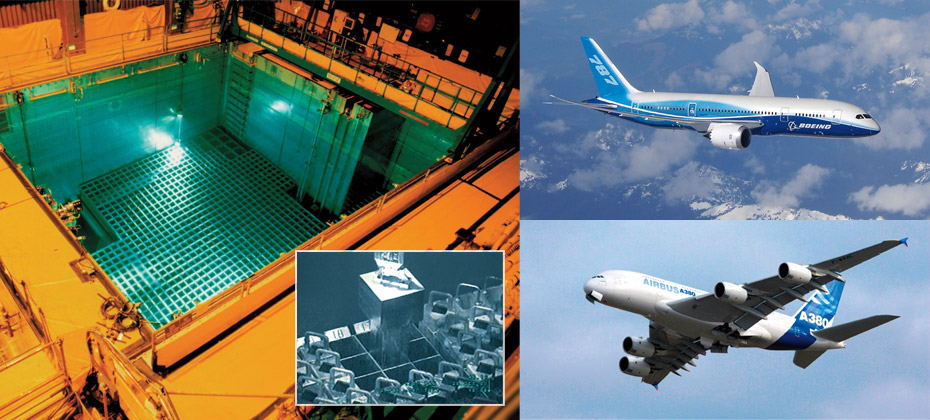
(Above Left) Curtiss-Wright is a leading authority and supplier of critical components needed to maintain the efficient, safe operation of nuclear power plants around the world. We provide unique spent nuclear fuel management products and services, including a patented neutron-absorbing product, the NETCO-SNAP-IN® insert, that extends the useful life of fuel storage racks submerged in spent fuel pools.
(Above Right) With an engineering legacy that originated with Glenn Curtiss and the Wright brothers, Curtiss-Wright technology is found on the latest generation of commercial airliners.
In collaboration with some of the world's leading aerospace partners, Curtiss-Wright is supporting Boeing's 787 "Dreamliner" — the world's first major aircraft to use composite materials for a majority of its structure — by supplying the large cargo door mechanisms, aft strut fairing module, linear and rotary position sensors for primary and secondary flight controls, solenoids and components for nose wheel steering control and the environmental control system.
For the Airbus A380 — the world's largest commercial aircraft — Curtiss-Wright shot peens structural components, including the wing skins, ribs, spars and stringers. We also supply the cabin pressure relief valve actuators, linear position sensors and solenoids.
A key issue for operators of nuclear facilities is managing their growing stockpile of spent nuclear fuel. We are a leader in spent fuel storage technology, supplying products and services that extend the safe and useful life of spent fuel pools and addressing regulatory requirements related to the safe, efficient operation of nuclear power plants.
Curtiss-Wright's product portfolio for the oil and gas market has evolved from that of a customized component supplier to an integrated system provider — important to both new refineries in emerging markets and mature facilities. The success of our coke-drum unheading system for the delayed coking process has stimulated demand for our other related technologies, including isolation valves, cutting tools to remove coke and control and automation systems that manage coker operations. Our integrated solutions optimize operations and enhance safety for our customers.
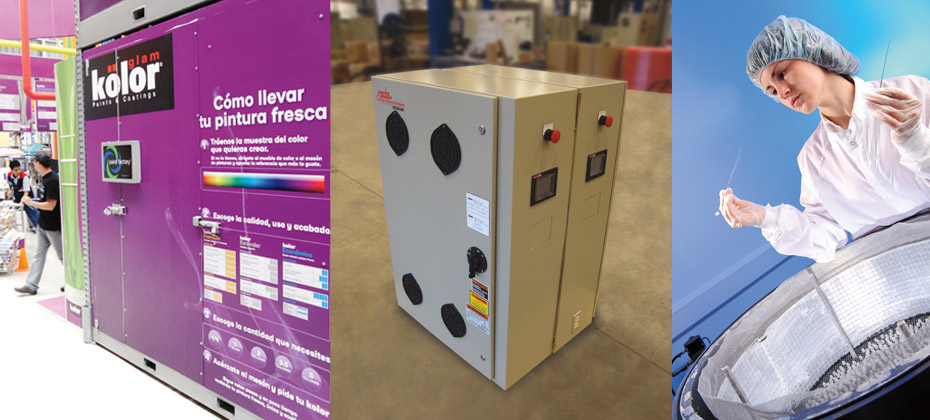
(Above Left and Center) Currently undergoing in-store testing with an international home improvement center retail chain, the MicroBlend Automated Paint Machine™ system is a revolutionary approach to the paint sales process. The system ensures greater process repeatability and more efficient dispensing of paint for retailers, while providing customers with superior color matching, greater color selection and faster service. Custom automated controls and software from our Benshaw business unit are integral to reducing the system's setup time, improving process consistency and safeguarding accuracy.
(Above Right) Parylene coatings applied by Curtiss-Wright are utilized by the medical device industry on coronary artery stents, rubber/silicone seals and wire forming mandrels used in the manufacture of catheters. The coating has unique end-use properties of lubricity, moisture impermeability, solvent resistance and biocompatibility. Parylene coatings are also used in electronic, oil and gas and general industrial applications.
Advances in equipment performance bring with them greater demands on component materials, and nowhere is this more apparent than with aerospace technology. By capitalizing on our metal treatment expertise, original equipment manufacturers can significantly improve the stress limits and fatigue life of critical airframe structures and turbine engine components. Advancements in our laser peening technology will enable us to establish a mobile laser peening facility in Southern California in 2011 to provide services directly on the F-22 Raptor aircraft structure. Similar mobile laser peening units will be deployed in Singapore and elsewhere in the Far East to support that region's growing turbine engine manufacturing infrastructure.
Technological advancements require more than just operational excellence. We have continued to make major investments in new technologies and products, and we have simultaneously deepened and expanded the reach of our core competencies.




